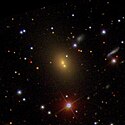IC 409
| Galaxie IC 409 | |
|---|---|
 | |
| SDSS-Aufnahme | |
| AladinLite | |
| Sternbild | Orion |
| Position Äquinoktium: J2000.0, Epoche: J2000.0 | |
| Rektaszension | 05h 19m 33,550s[1] |
| Deklination | +03° 19′ 06,20″[1] |
| Erscheinungsbild | |
| Morphologischer Typ | S[2] |
| Helligkeit (visuell) | 14,2 mag[2] |
| Helligkeit (B-Band) | 15 mag[2] |
| Winkelausdehnung | 0,7′ × 0,5′[2] |
| Positionswinkel | 30°[2] |
| Flächenhelligkeit | 12,9 mag/arcmin²[2] |
| Physikalische Daten | |
| Rotverschiebung | 0.028320 ± 0.000110[1] |
| Radialgeschwindigkeit | (8490 ± 33) km/s[1] |
| Hubbledistanz H0 = 73 km/(s • Mpc) | (376 ± 26) · 106 Lj (115,2 ± 8,1) Mpc [1] |
| Durchmesser | 75.000 Lj[3] |
| Geschichte | |
| Entdeckung | Stéphane Javelle |
| Entdeckungsdatum | 12. Januar 1894 |
| Katalogbezeichnungen | |
| IC 409 • PGC 17105 • CGCG 421-026 • MCG +01-14-024 • 2MASX J05193366+0319036 • NVSS J051933+031906 | |
IC 409 ist eine binukleare elliptische Galaxie vom Hubble-Typ E im Sternbild Orion am Nordsternhimmel. Sie schätzungsweise 376 Millionen Lichtjahre von der Milchstraße entfernt und hat einen Durchmesser von etwa 75.000 Lichtjahren.
Im selben Himmelsareal befinden sich u. a. die Galaxien IC 412, IC 414, IC 2123, IC 2124.
Das Objekt wurde am 12. Januar 1894 vom französischen Astronomen Stéphane Javelle entdeckt.[4]
Weblinks
Einzelnachweise
Auf dieser Seite verwendete Medien
Autor/Urheber: Sloan Digital Sky Survey, Lizenz: CC BY 4.0

Angle of view: 4' × 4' (0.3" per pixel), north is up.
Details on the image processing pipeline: https://www.sdss.org/dr14/imaging/jpg-images-on-skyserver/